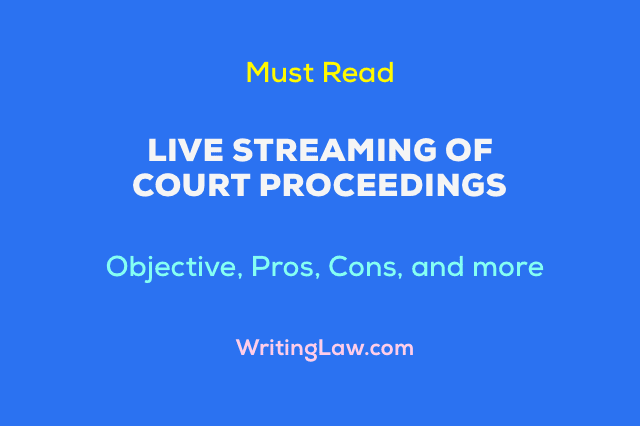
The sudden striking of the Coronavirus pandemic has created immense demand for virtual hearings of the court, starting from the lowest court to the apex court. This has become a trend nowadays because of its time-saving feature and fast-tracking of cases.
The viewing/live streaming of the court proceedings is restricted to lawyers and clients only instead of the public. Since both the central and state governments are bringing transparency in their departments, how can the Indian judiciary be subtracted from it by retaining public confidence within the same? There are certain advantages and disadvantages, which are outlined below.
Note: In a first, Gujarat High Court has started live streaming of court proceedings on YouTube.
Background
- All the courts started operating in virtual mode throughout the pandemic.
- In model video conferencing rules of the Supreme Court, public viewing of court proceedings through video conferencing has been stated.
- The apex court had favoured the live streaming of court proceedings in the recent case outlined below.
- Live Streaming of court proceedings through video conferencing mode is a part of the right to access justice as stated by the apex court.
Objective of Live Streaming of Court Proceedings
The main objectives of live streaming the Supreme Court, High Court, and other court’s live proceedings for general people are as follows:
- To boost the faith of the people in the judiciary.
- To activate the right to access justice which remained dormant partially since independence.
- The demand for a smart judiciary over time.
- To reduce cost.
- To reduce corruption.
- To arrest the irregularities in the judiciary.
- To aid legal research.
- To help law aspirants gain knowledge.
Swapnil Tripathy Case Law
Swapnil Tripathy vs Supreme Court 2018: The apex court opined:
“sunlight is the best disinfectant. Live-streaming as an extension of the principle of open courts will ensure that the interface between a court hearing with virtual reality will result in the dissemination of information in the widest possible sense, imparting transparency and accountability to the judicial process”. [Para 18(h)]
The apex court had also said that “live streaming of court proceedings is a part of the right to access justice under Article 21 of the Constitution“. But still, the judgement is unimplemented.
Advantages of Live Streaming of Court Proceedings
Live streaming of court proceedings has several advantages. They are:
- Litigants can view their lawyer’s presentation and access the same.
- Without coming to court from far-flung areas, litigants can view live proceedings in the comfort of their place.
- Live streaming of court proceedings will bring transparency to the judiciary.
- Fewer Interruptions, raised voices, adjournments etc., by the lawyers can be avoided.
- Live streaming of court proceedings will be of academic help.
- Live streaming of court proceedings will also help in legal research.
- Impugned orders and judgements can be avoided.
- Cost-effective.
Disadvantages of Live Streaming of Court Proceedings
Live streaming of Indian court proceedings has its share of drawbacks. Some of the main disadvantages are:
- High data security and privacy are needed.
- Some cases, such as rape, matrimonial cases, etc., cannot be live-streamed.
- Infrastructure and high-speed internet connectivity are needed.
- The court cannot rely upon third-party software and services for safety.
- Litigants and counsels from rural areas face the digital divide in a developing country like India.
- Control of unauthorised reproduction of the proceedings by the cyber-criminals will be challenging on the part of the Government.
Way Forward
- Court proceedings’ live streaming is a part of the right to access justice.
- Transparency reimburses the faith of the public in the judiciary.
- Time limits must be specified for oral arguments. Preference shall be given to written briefs.
- There must be a time delay of approximately 10 minutes for the time to edit.
- Important cases such as rape, matrimonial disputes, and cases of national importance must not be telecast.
Read Next:
1. Role of AI in Legal Education and Legal Profession
2. What Are E-Contracts as Per the Indian IT Act?
3. Top 6 Major Flaws in the Current Indian Judicial System
- 10 Types or Kinds of Jurisdiction of Indian Courts - 13th April 2022
- Malicious Charge of Offence Under Section 211 of the Indian Penal Code - 17th March 2022
- About Supreme Court of India – Collegium, Powers, Judges - 7th February 2022








No doubt live streaming may have some practical issues but it is the best at present to save the time money energy more over mental agony of the public. Also to more helpful to the law students and young lawyers. O welcome live streaming.
Thank you for sharing your opinion.
Advantages far outweigh disadvantages. With the help of modern technology, all the disadvantages can be controlled, provided there is a will to deliver open justice.
Happy to read your thoughts on this.